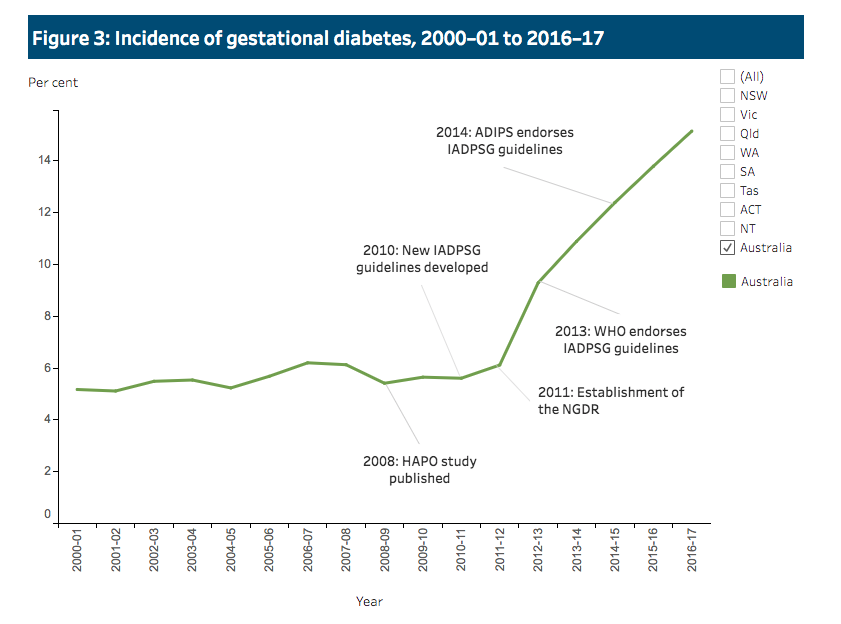New diagnostic guidelines for gestational diabetes likely contributed to a tripling in rates of reported gestational diabetes from 5% in 2000–01 to 15% in 2016–17, according to a new report.
Latest figures from the Australian Institute of Health and Welfare show that 40,800 pregnant women (one in seven) who gave birth in hospital were diagnosed with gestational diabetes in 2016–17.
The incidence rate for gestational diabetes increased with age, ranging from 9% in the 20-24 age group and peaking in the 45–49 year age group at 26%.
Women were more likely to be diagnosed with gestational diabetes if they were born in Asia, North Africa and the Middle East, or if they were socioeconomically disadvantaged.

Figure: AIHW
However the report authors cautioned that the major increase seen in rates of diagnosed gestational diabetes from 2012 onwards was likely due to the dissemination and adoption of new IADPSG Criteria for the Screening and Diagnosis of Gestational Diabetes Mellitus.
“Whilst the IADPSG guidelines were not endorsed by ADIPS until 2014, establishment of the National Gestational Diabetes Register (NGDR) by Diabetes Australia in 2011 (to assist in the post-natal support of women diagnosed with gestational diabetes and to remind them to have regular diabetes screening) and endorsement of the IADPSG guidelines by the World Health Organisation in 2013, may have had an impact on awareness and screening in Australia,” they wrote.
“The endorsement of the IADPSG guidelines by ADIPS in 2014 represented a significant change to the practice of testing and diagnosing gestational diabetes in Australia. The guidelines were implemented across most jurisdictions by mid-2016.”
The report shows that more than half (56%) of women were recorded as having managed their condition without medication through the use of diet, exercise and/or lifestyle management.
Just under a third (32%) had been treated with insulin therapy, and 8% had been treated with oral hypoglycaemic medications
The report notes that the 2014 Australasian Diabetes in Pregnancy Society (ADIPS) consensus guidelines recommend early testing in pregnancy for women with risk factors for gestational diabetes using the 75g pregnancy Oral Glucose Tolerance Test (OGTT). Routine testing for gestational diabetes using the OGTT is recommended for all women at 24–28 weeks gestation, including higher risk women recording normal blood glucose results in early pregnancy.